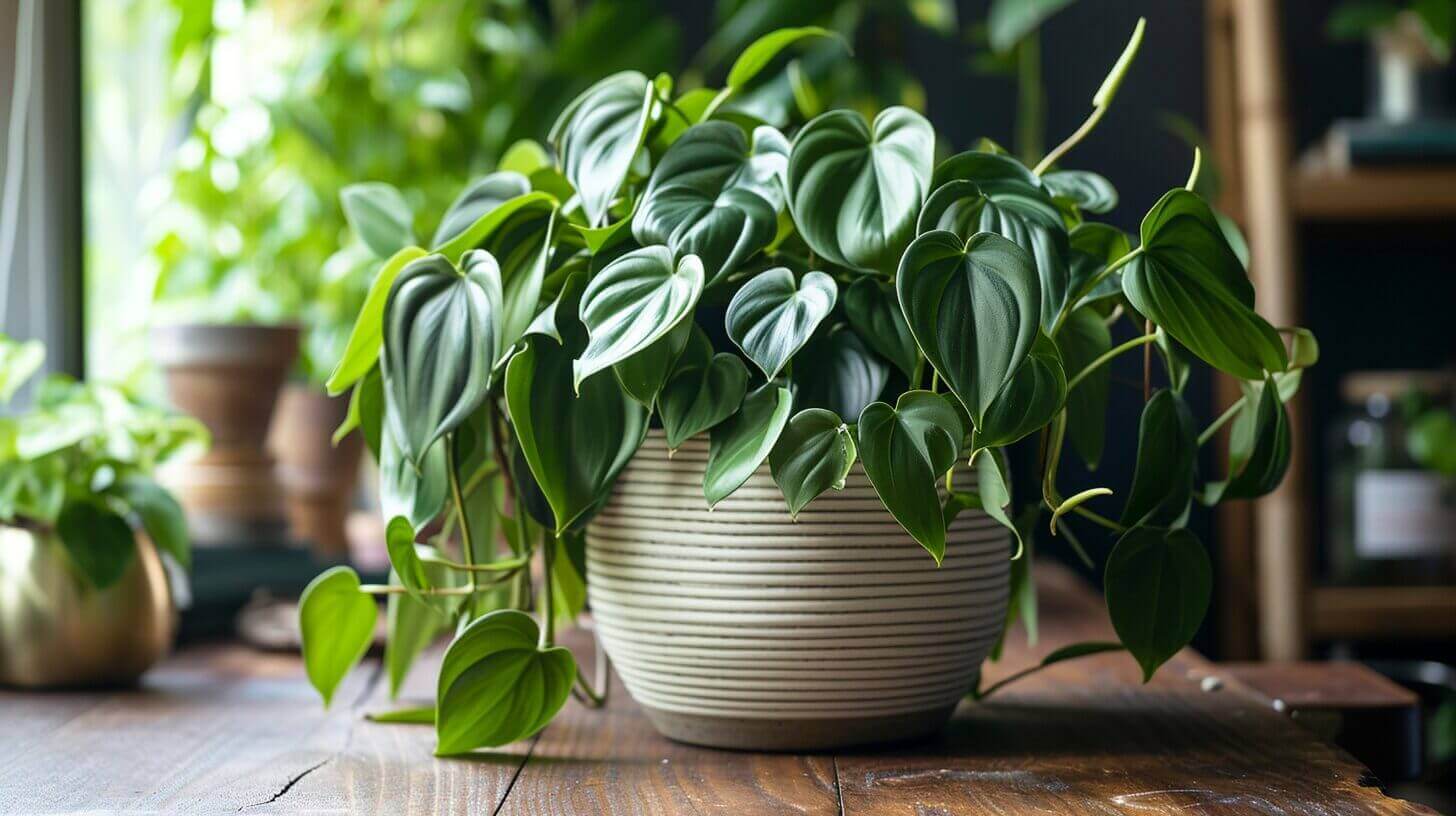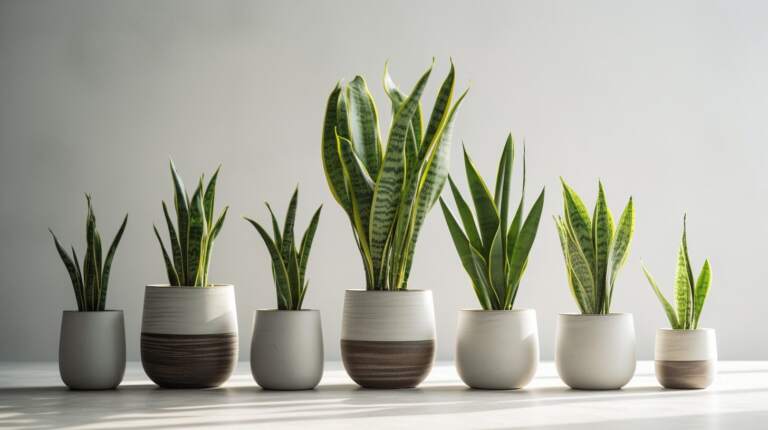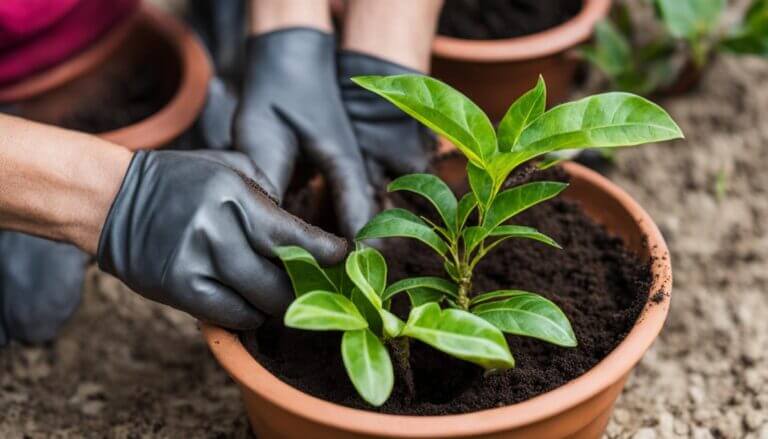When Is Time to Repot Your Philodendron Plant: Signs Your Philodendrons Needs a Bigger Pot
Did you know that over 70% of indoor plants suffer from being pot bound? If you’re a proud philodendron owner, you’ll want to ensure your plant is thriving in a suitable environment.
In this article, we will explore the telltale signs that indicate it’s time to repot your philodendron. From yellowing leaves to restricted root growth, we’ll provide valuable insights on when and how to give your plant the bigger pot it deserves.
Key Takeaways
- Yellowing leaves can indicate a need for repotting.
- Waterlogged soil can be detrimental to philodendron’s health.
- Slow or stunted growth can indicate the need for a larger pot.
- Pot-bound roots can severely impact the growth and health of a philodendron.
Repot Philodendron – Yellowing Leaves
One common sign that indicates your philodendron plant may need to repot is the presence of a few yellowing leaves. Leaf discoloration can be a result of various factors, including nutrient deficiencies, overwatering, or inadequate drainage.
However, if you have ruled out these issues and your plant’s leaves continue to turn yellow, it may be a sign that the roots have outgrown the current pot. When a philodendron becomes root-bound, it can experience transplant shock, which manifests as yellowing leaves.
Repotting the plant into a larger pot allows the roots to spread out and access more nutrients, ultimately helping the plant regain its health and vitality. So, if you notice yellowing leaves on your philodendron, it’s time to consider repotting it into a bigger container.
Repot a Philodendron – Restricted Root Growth
To ensure optimal growth and health for your philodendron, it is important to recognize the signs of restricted root growth and take appropriate action.
One of the main causes of restricted root growth is improper drainage, which can lead to waterlogged soil and overwatering risks. When the roots of your philodendron are confined and unable to spread out, it can hinder their ability to absorb nutrients and water efficiently.
Signs of restricted root growth include stunted growth, yellowing leaves, and a general lack of vitality in the plant. If you notice these signs, it means you need to repot your philodendron into a larger pot with proper drainage to allow its roots to grow freely and promote healthy development.
Moving forward, let’s discuss the dangers of waterlogged soil and how it can affect your philodendron’s well-being.
Repot Your Philodendron – Waterlogged Soil
Waterlogged soil can be detrimental to the health of your philodendron, so it is important to understand the signs and take action if necessary. Philodendrons are tropical plants that thrive in well-draining soil, so when the soil becomes waterlogged, it can lead to root rot and suffocation of the roots.
To prevent overwatering and waterlogged soil, it is crucial to choose the right pot size for your philodendron. A pot that is too large will retain excess water, while a pot that is too small may not provide enough space for the roots to grow. It is recommended to choose a pot that is one size larger than the current pot, allowing for proper drainage and root development.
By choosing the right pot size and monitoring the moisture levels of the soil, you can prevent waterlogged soil and ensure the health of your philodendron.
In addition to waterlogged soil, slow or stunted growth can also indicate that your philodendron needs a bigger pot.
When Is Time to Repot Philodendron Plant – Slow or Stunted Growth
When a philodendron exhibits slow or stunted growth, it may be an indication that the plant requires a larger pot. Here are three reasons why slow or stunted growth can be a sign of the need for repotting:
- Nutrient deficiency: As a philodendron grows, it depletes the nutrients present in its current potting mix. If the plant is not repotted into fresh soil with adequate nutrients, it may struggle to grow and develop properly.
- Overcrowding issues: When a philodendron becomes root-bound, with roots tightly packed in its current pot, it can lead to slow growth. The lack of space restricts the plant’s ability to access water and nutrients, hindering its growth potential.
- Lack of oxygen: In a small pot, the roots of a philodendron may not have enough access to oxygen. This can impede growth and result in stunted development.
Sign That Your Philodendron Need To Be repotted – Root Bound
Despite being a common occurrence, pot bound roots can severely impact the growth and health of a philodendron over time. When a plant becomes pot bound, it means that the roots have filled up the available space in the container, leaving no room for further growth. This can lead to a variety of problems for the plant, including nutrient deficiency, reduced water absorption, and restricted root development.
To address this issue, root pruning and repotting are necessary. Root pruning involves trimming the roots to stimulate new growth and prevent them from becoming tangled or overcrowded. Repotting, on the other hand, involves transferring the plant to a larger container, allowing the roots to spread out and access more nutrients and water. Choosing the right container size is crucial to ensure the plant has enough room to grow and thrive.
Frequently Asked Questions
What is the Best Time to Propagate Philodendron Cuttings?
Whether you are a seasoned gardener or a beginner, understanding step-by-step philodendron cutting propagation is crucial. To get the best results, it’s important to know when to propagate these cuttings. The ideal time to propagate philodendron cuttings is during the warmer months of spring and summer when the plants are actively growing. This period promotes successful rooting and avoids potential setbacks.
Can I Repot My Philodendron in Any Season or Is There a Specific Time of Year That Is Best?
The best time to repot a philodendron depends on the specific needs of the plant. Generally, it is recommended to repot during the active growing season, which is typically in spring or early summer. This allows the plant to recover quickly from the repotting process and establish itself in the new pot.
However, if the philodendron shows signs of being root-bound or if the current pot is too small, it may be necessary to repot it at any time of the year.
How Often Should I Water My Philodendron After Repotting?
After repotting a philodendron, it is important to establish a proper watering routine to ensure the plant’s health and growth. The frequency of watering may vary depending on factors such as the plant’s size, pot size, and environmental conditions.
Generally, it is recommended to water the philodendron thoroughly until water drains from the bottom of the pot. Allow the top inch of soil to dry out before watering again.
Signs of overwatering after repotting may include wilting, yellowing leaves, and root rot. It is crucial to monitor the plant’s moisture levels and adjust watering accordingly.
Are There Any Specific Care Instructions I Need to Follow After Repotting My Philodendron?
After repotting your philodendron, it is important to follow certain care instructions to ensure its health and well-being.
One common mistake to avoid is overwatering the plant immediately after repotting, as this can lead to root rot. Instead, allow the plant to settle into its new pot for a few days before watering.
Additionally, provide the philodendron with indirect sunlight and maintain a consistent watering schedule to promote healthy growth.
Can I Divide My Philodendron When Repotting to Create Multiple Plants?
Philodendron division during repotting is a viable method for propagating multiple plants. By dividing the root ball into separate sections, each with its own set of roots, you can create new philodendron plants. This process has several benefits, including the ability to expand your plant collection, share plants with others, or simply refresh the appearance of your space.
Philodendrons are known for their ease of propagation, and division is a reliable way to achieve this.
How often should I repot my philodendron?
It’s best to repot your philodendron every 2-3 years, or when you notice your plant has outgrown its pot. However, pay attention to your plant’s health and growth, as some may need repotting more frequently.
When is the best time to repot a philodendron?
The best time to repot a philodendron is during the growing season, typically in the spring or early summer. This gives the plant time to adjust to its new pot before the slower growth period in the winter.
What are the signs that my philodendron needs repotting?
Signs it’s time to repot include roots growing out of the bottom of the pot, water running straight through the pot without being absorbed, or if the plant seems top-heavy and unstable.
How do I know if my philodendron needs a bigger pot?
If your philodendron’s roots are crowded and start to grow out of the drainage holes, or if the plant dries out quickly after watering, it may need a bigger pot.
What steps should I follow when repotting my philodendron?
To repot your plant, first remove the plant from its current pot. Then, place some fresh potting soil at the bottom of the new pot. Position your philodendron in the center of the pot, then fill in around it with more soil. Finally, water your philodendron thoroughly.
Can I repot my philodendron in any type of pot?
While you can use any type of pot for your philodendron, it’s important to ensure your philodendron’s new pot has good drainage to prevent root rot.
What type of soil should I use when repotting my philodendron?
When repotting your philodendron, use a well-draining potting soil. You can also add some perlite or orchid bark for extra drainage.
How do I care for my philodendron after repotting?
After repotting, water the plant thoroughly and place it in a location with indirect light. Avoid fertilizing for a few weeks to allow your philodendron to adjust to its new environment.
What are the Signs That My Philodendron Needs a Bigger Pot?
Transplanting a philodendron into a larger pot is necessary when certain signs manifest. These indications include the roots becoming root-bound, visible roots sticking out of the drainage holes, or slow growth despite regular watering and fertilize philodendron efforts. A bigger pot will provide the plant with more space for optimal growth and development.
Can all types of philodendrons be repotted in the same way?
Most types of philodendrons can be repotted using the same general steps. However, always consider the specific needs of your particular variety.
What should I do if my philodendron shows signs of stress after repotting?
If your plant shows signs of stress after being repotted, such as wilting or yellowing leaves, ensure it’s getting proper light and water. If problems persist, consider consulting with a local nursery or extension service.







